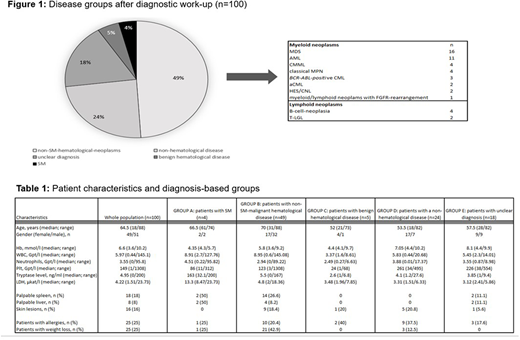Systemic mastocytosis (SM) is reported to be a rare myeloid disease. The true incidence is unknown as the diagnosis is often missed due to the diversity of symptoms and signs. In the HRYD study, we hypothesized that the reported incidence of around 1/100000/year is too low and the assumed underdiagnosis could be reduced if serum tryptase, although only a minor criterion for the diagnosis of SM, would be measured in patients (pts) with cytopenia and/or leukocytosis.
Methods: HRYD was a prospective single-center trial. The protocol was approved by the local ethics committee. The primary endpoint was the incidence of SM in a consecutive cohort of 100 unselected pts with unclear cytopenia and/or leukocytosis at the University Hospital Halle. Pts with suspected or known SM or cutaneous mastocytosis were excluded. Serum tryptase levels were measured at initial presentation (normal < 11 ng/ml). The diagnosis and classification of SM were based on the 2016 WHO classification where a baseline tryptase level > 20 ng/mL is considered as a minor criterion for SM. Routine diagnostic work-up included medical history, physical examination, blood analyses (blood picture, differential count, liver and renal function, albumin, and further tests as needed), and if indicated a bone marrow biopsy and aspiration for cytology, immunophenotyping, karyotyping, and molecular diagnostics as appropriate. Mutational profiling from a peripheral blood sample with next-generation sequencing (NGS) was done if required. All pts gave informed consent.
Results: 100 pts (51% males) > 18 years (y) were recruited between February, 2019 and June, 2020. Median age was 64.5 (range 18-88) y. Based on the final diagnosis, pts were allocated to five subgroups (group A: SM, group B: non-SM malignant hematological diseases, group C: benign hematological diseases, group D: non-hematological diseases, group E: unclear diagnosis at data-cut-off) (table 1). For the entire cohort, fatigue (n=46), weight loss (n=25), and dyspnea (n=15) were the most frequent symptoms at presentation. A non-SM malignant disease (group B) was most frequently diagnosed (n=49) followed by a non-hematological cause (n=24) (figure1). With a median age of 70 (31-88) y, pts in group B tended to be older compared to those in groups C and D. Serum tryptase > 20 ng/ml was detected in 9 pts (median level 53.4, range 21.6-200) ng/ml. SM was diagnosed in 4 (4%) pts (group A). The remaining 5 pts belonged to group B, n=4 and group D, n=1. A history of allergies, skin lesions, hepatomegaly, and/or splenomegaly were not predictive for the diagnosis of SM. The median tryptase level in SM pts was 163 (range 32.1-200) ng/ml. All pts in group A suffered from SM with associated hematologic neoplasm (SM-AHN). The AHN were MDS, n=1; MPN, n=1; AML, n=2. A KIT point mutation at codon 816 was detected in one of the SM-AHN pts. Overall, a diagnosis of SM could be excluded with a probability of 85.4% and a specificity of 95% if the tryptase level was < 20 ng/ml. On the other hand and although sensitivity was 100%, the positive predictive value of a serum tryptase > 20 ng/ml for SM was only 44.4%. WBC, Hb, and platelets did not correlate with tryptase levels or the final diagnosis in all groups. In group B, three pts with BCR-ABL positive CML were diagnosed. In contrast to SM-AHN pts, marked leukocytosis with a WBC >100x109/L was present in the CML pts. NGS was performed in 27 pts. A median of 3 (range 0-8) somatic mutations were detected. From a diagnostic point of view, the added value of NGS was met in 8/27 (30%) pts.
Conclusions: In an unselected cohort of pts with undiagnosed cytopenia and/or leucocytosis, the incidence of SM-AHN was higher than that for BCR-ABL positive CML. Our data question the low reported epidemiological data to SM. Because of the prognostic and therapeutic consequences of a correct diagnosis and despite the low positive predictive value of an elevated tryptase for the diagnosis of SM, including the cheap serum tryptase test in the work-up of pts with unclear clinical scenarios and abnormal hematological parameters is a simple tool to increase awareness of physicians to SM as a differential diagnosis. SM is highly unlikely if the tryptase level is below 20 ng/ml.
Niederwieser:Amgen: Speakers Bureau; Daiichi: Research Funding; Cellectis: Membership on an entity's Board of Directors or advisory committees; Novartis: Speakers Bureau. Al-Ali:Celgene: Honoraria, Research Funding; Novartis: Honoraria, Research Funding.
Author notes
Asterisk with author names denotes non-ASH members.


This feature is available to Subscribers Only
Sign In or Create an Account Close Modal